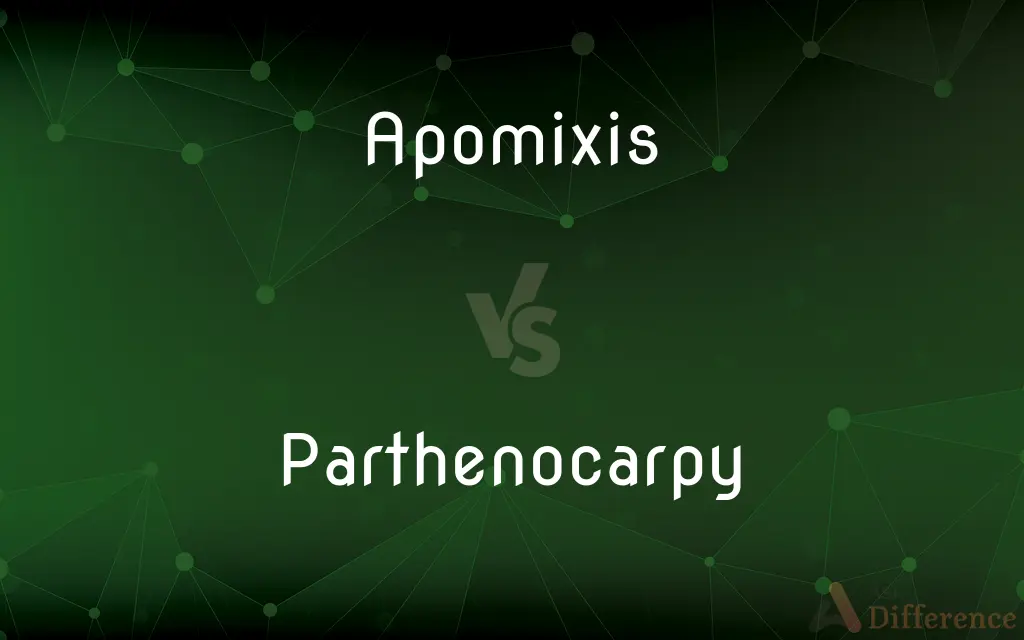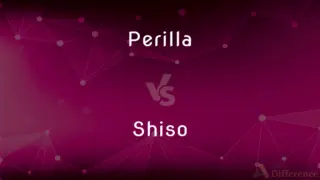Apomixis vs. Parthenocarpy — What's the Difference?
By Tayyaba Rehman — Updated on September 23, 2023
Apomixis is asexual seed production without fertilization; Parthenocarpy is fruit development without seed formation or fertilization.

Difference Between Apomixis and Parthenocarpy
Table of Contents
ADVERTISEMENT
Key Differences
Apomixis and Parthenocarpy, both fascinating botanical phenomena, play unique roles in plant reproduction. Apomixis allows plants to produce seeds without undergoing the typical process of fertilization. This means, through Apomixis, offspring arise from a single parent, maintaining genetic uniformity. Parthenocarpy, in contrast, refers to the development of fruit without seeds or prior fertilization.
Though both Apomixis and Parthenocarpy sidestep the standard sexual reproduction process, their end results differ. While Apomixis ensures the formation of seeds that are genetically identical to the parent, Parthenocarpy leads to seedless fruits, a trait appreciated in certain agricultural contexts, like producing seedless grapes or bananas.
Apomixis is predominantly found in some grasses, daisies, and citrus fruits. This process ensures a stable, unchanging lineage as there's no genetic mixing. Parthenocarpy, however, can be both naturally occurring or induced through specific treatments, leading to fruits like the common seedless watermelon.
Understanding both Apomixis and Parthenocarpy is pivotal for agricultural advancements. Apomixis can simplify breeding processes and ensure uniform crop production, while Parthenocarpy can cater to consumer preferences for seedless fruits.
Comparison Chart
Definition
Asexual seed production
Fruit development without seeds or fertilization
ADVERTISEMENT
Result
Genetically identical seeds
Seedless fruits
Genetic Contribution
From a single parent
N/A (No seeds)
Found in
Grasses, daisies, some citrus fruits
Bananas, seedless grapes, watermelon
Role in Agriculture
Simplifies breeding, uniform crops
Meets consumer preference for seedless fruits
Compare with Definitions
Apomixis
Ensures stable and unchanging lineages in plants.
Due to Apomixis, certain daisy species maintain consistent genetic traits.
Parthenocarpy
Development of fruit without fertilization.
Bananas available in stores often exhibit Parthenocarpy, as they are seedless.
Apomixis
Bypasses the typical fertilization process.
Apomixis results in offspring genetically identical to the parent.
Parthenocarpy
Can be natural or artificially induced.
Breeders induce Parthenocarpy in certain fruit types to meet market demand.
Apomixis
Seen in specific plants like daisies and citrus.
Citrus growers often use Apomixis to maintain consistent fruit quality.
Parthenocarpy
Skips the seed formation phase.
With Parthenocarpy, fruits develop directly from the ovary without seed creation.
Apomixis
Asexual seed production in plants.
Some grass varieties reproduce through Apomixis.
Parthenocarpy
Appreciated for consumer-friendly fruits.
Seedless watermelons, a result of Parthenocarpy, are popular among consumers.
Apomixis
Beneficial for consistent agricultural yield.
Apomixis is studied for its potential in predictable and uniform crop production.
Parthenocarpy
Leads to seedless fruit production.
Parthenocarpy in grapes results in varieties without seeds.
Apomixis
In botany, apomixis is asexual reproduction without fertilization. Its etymology is Greek for "away from" + "mixing".
Parthenocarpy
In botany and horticulture, parthenocarpy is the natural or artificially induced production of fruit without fertilisation of ovules, which makes the fruit seedless. Stenospermocarpy may also produce apparently seedless fruit, but the seeds are actually aborted while they are still small.
Apomixis
The development of an embryo without the occurrence of fertilization, especially in plants.
Parthenocarpy
The production of fruit without fertilization.
Apomixis
(botany) Plant reproduction without fertilization.
Parthenocarpy
(botany) production of (seedless) fruit without fertilization of ovules.
Apomixis
(botany) Plant reproduction without fertilization, meiosis, or the production of gametes.
Parthenocarpy
(botany) the development of a fruit without fertilization or seeds
Apomixis
(zoology) Animal reproduction in which the egg cell does not undergo meiosis or fertilization.
Apomixis
Any of several kinds of reproduction without fertilization
Common Curiosities
Can Parthenocarpy be induced?
Yes, Parthenocarpy can be both naturally occurring or induced in certain fruits.
Why is Apomixis significant in agriculture?
Apomixis ensures uniform crop production and simplifies breeding processes.
What is Apomixis?
Apomixis is asexual seed production without the process of fertilization.
What are the benefits of Parthenocarpy in agriculture?
Parthenocarpy meets consumer preferences for seedless fruits, which are often more convenient to consume.
How does Parthenocarpy differ from Apomixis?
Parthenocarpy leads to the development of fruit without seeds or fertilization, while Apomixis results in asexual seed production.
Are seedless grapes a result of Parthenocarpy?
Yes, seedless grapes are a product of Parthenocarpy.
Do plants produced from Apomixis require pollination?
No, plants produced via Apomixis do not require pollination for seed production.
What results from Apomixis in plants?
Apomixis results in the production of genetically identical seeds without fertilization.
In which fruits is Parthenocarpy naturally occurring?
Bananas and certain varieties of grapes and watermelons exhibit natural Parthenocarpy.
Is Parthenocarpy a genetically modified process?
While Parthenocarpy can be induced artificially, it also occurs naturally in some plants.
Do both processes bypass standard sexual reproduction?
Yes, both Apomixis and Parthenocarpy bypass typical sexual reproduction in plants.
Does Apomixis lead to genetic diversity?
No, Apomixis leads to offspring genetically identical to the parent, ensuring genetic uniformity.
Does Parthenocarpy lead to the creation of seeds?
No, Parthenocarpy results in the formation of seedless fruits.
Which is more common, Apomixis or Parthenocarpy?
Both processes occur in nature, but their prevalence varies depending on the plant species and context.
Can both Apomixis and Parthenocarpy occur in the same plant?
While theoretically possible, it's uncommon for a single plant to exhibit both Apomixis and Parthenocarpy.
Share Your Discovery

Previous Comparison
Perilla vs. Shiso
Next Comparison
Auntie vs. GrannyAuthor Spotlight
Written by
Tayyaba RehmanTayyaba Rehman is a distinguished writer, currently serving as a primary contributor to askdifference.com. As a researcher in semantics and etymology, Tayyaba's passion for the complexity of languages and their distinctions has found a perfect home on the platform. Tayyaba delves into the intricacies of language, distinguishing between commonly confused words and phrases, thereby providing clarity for readers worldwide.















































